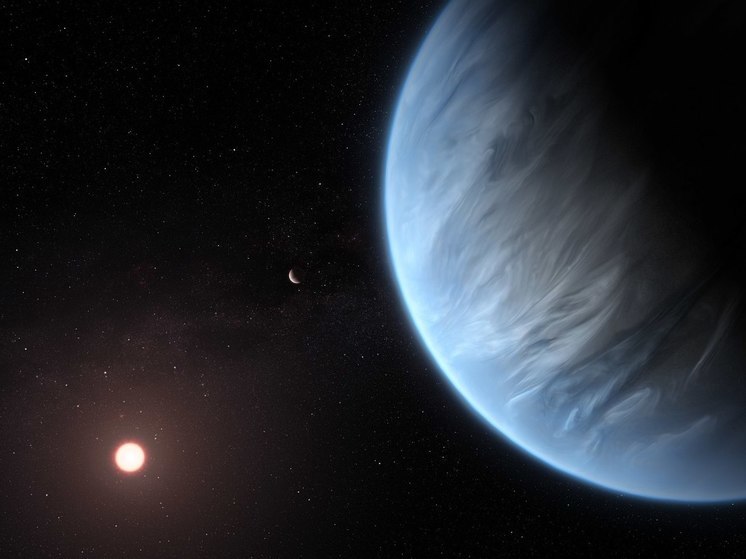Scientists intrigued by discovery of life-related molecule
NASA says a distant exoplanet discovered may harbor a rare water ocean and a possible hint of life. To avoid raising expectations too high, the US space agency cautioned that the potential detection of dimethyl sulfide on K2-18b, produced only by life on Earth, has not yet been fully confirmed.
 Photo: ESA/Hubble
Photo: ESA/Hubble
NASA scientists have announced the possible existence of a rare water ocean on a giant exoplanet dozens of light years away, as well as a chemical hint of potential life.
As The Guardian reports, an “intriguing” The discovery was made by the James Webb Telescope, located 120 light-years from Earth in the constellation Leo, building on earlier studies of the region using Webb's predecessors, Hubble. and «Kepler».
Researchers named the exoplanet K2-18 – an unremarkable name for something of such potential significance, notes The Guardian. NASA says it is an exoplanet with nearly nine times the mass of Earth: «an exoplanet that potentially has a hydrogen-rich atmosphere and a surface covered by a water ocean.»
The space agency said its observations of the planet's atmospheric chemistry suggested the possibility of an oceanic world. “The abundance of methane and carbon dioxide, as well as the lack of ammonia, support the hypothesis that there may be a water ocean beneath the hydrogen-rich atmosphere in K2-18b,” NASA said in a statement.
But the agency also hinted at an even more exciting possibility is the potential discovery of a molecule called dimethyl sulfide (DMS), which on Earth is formed only as a result of life.
“The bulk of DMS in the Earth's atmosphere is released by phytoplankton in the marine environment,” NASA release.
However, the presence of dimethyl sulfide remains to be confirmed and requires further investigation. «Webb's upcoming observations should confirm whether DMS is indeed present in the atmosphere of K2-18 b at significant levels,» says Nikku Madhusudhan, an astronomer at the University of Cambridge and lead author of the NASA study.
This will not be the first time that NASA has discovered signs of the presence of water on other planets, writes The Guardian. Water vapor was previously discovered on the smaller exoplanet HAT-P-11b, roughly the size of Neptune in the constellation Cygnus, also 120 light-years away.
But scientists are excited about the discovery, although they caution that this does not necessarily mean that life can exist on the planet.
“Our results highlight the importance of considering a variety of habitable environments when searching for life elsewhere,” says Nikku Madhusudhan. – Traditionally, the search for life on exoplanets has focused primarily on small, rocky planets, but the larger Hykean worlds are significantly more favorable for atmospheric observations. ;.
Orbiting the cool dwarf star K2-18, the exoplanet, which has a radius 2.6 times the radius of Earth, lies in what NASA calls the habitable zone, an area around the star where planets with liquid water may be present.
The exoplanet's interior likely contains a large mantle of high-pressure ice similar to Neptune, but likely has a thinner, hydrogen-rich atmosphere and ocean surface, NASA said. The Hycean planets are predicted to have oceans of water, but on K2-18b it is also possible that the ocean is too hot to be habitable.
The planet's existence was first discovered by NASA's K2 mission in 2015, but Webb's improved technology over earlier telescopes allowed for more detailed analysis and revealed that it may be an ocean world. Scientists were able to study a tiny portion of the star's light as it passed through the exoplanet's atmosphere.
“This result was only possible due to the extended wavelength range and unprecedented sensitivity of the Webb telescope, which made it possible to reliably detect spectral features in just two transitions,” says Madhusudhan. – By comparison, one transit observation with Webb provided comparable accuracy to eight observations with Hubble, conducted over several years and in a relatively narrow range of wavelengths.
In July, NASA celebrated the first anniversary of the Webb Space Telescope , publishing the “unprecedented” close-up image of the closest star-forming region to Earth.
In little more than a year, it has allowed people to get closer to the origins of the Universe than ever before, and to obtain high-resolution images of distant worlds and the mysterious structures that they surrounded, The Guardian reports. These include “rare and fleeting” the phase of a star on the verge of death; early galaxies formed just 350 million years after the big bang; and evidence of “universe-destroying galaxies,” far larger than scientists thought possible and potentially upending existing theories of cosmology.


